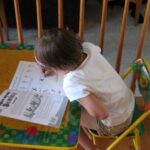The Multiple Intelligence Theory was developed by Howard Gardner in the early 1980’s and further developed in the early 1990’s. Gardner had experience working with gifted children as well as brain-injured adults and he discovered that intelligence manifests itself through several different areas. Gardner defines intelligence as the capacity to solve problems and create products that would be valued in a cultural setting. By this definition, Gardner composed seven different areas of intelligence which are as follows; Verbal/Linguistic, Visual, Musical, Interpersonal, Intrapersonal, Logical/mathematical, Bodily kinesthetic and he later added Naturalistic. Gardner also noted that while everyone is capable of performing within each intelligence area, most people are more gifted in certain areas than in others.
Claudia Cornett’s Creating Meaning through Literature and the Arts describes each intelligence area thoroughly. I will describe each intelligence area using Cornett’s text as a guide. Beginning with Verbal, this area involves the love of words. Verbal learners typically enjoy discussing, reading, writing, memorizing, and using humor. The next area is visual, which includes learners who enjoy drawing, designing, and the use of visual images. These learners typically do well with picture representations and are also gifted with mazes, puzzles, and maps. The next area is Musical. Musical learners love to sing and hum and are typically able to remember songs and melodies. People who are musical also often respond to music well and notice pitches and rhythms. The fourth area is Interpersonal, which involves learners who like working with others and are gifted in resolving conflicts and relating to others. Interpersonal learners also make good leaders and are able to cooperate well. The fifth area of intelligence, Intrapersonal, involves those who enjoy personal space and do well with reflecting on feelings, intentions and dreams. The sixth area of intelligence, Logical, includes learners who like to think and solve problems with their minds. People who are strong in this area are typically able to discover patterns, categorize and classify, and are usually gifted in math as well. The seventh area is Bodily Kinesthetic, which includes those who enjoy using gestures to communicate. These learners also typically enjoy hands-on learning, sports, drama, and dance. The final area of intelligence is Naturalistic. These learners typically enjoy studying animals and nature and being outside. Each area is important for teachers and learners to understand and be aware of. It is also important for teachers to address each learning style within their classroom so that all students not only get a chance to exercise their strengths, but also to develop their weaknesses.
I believe that individuals may gain strengths in other areas as time goes by. Personally, I have always been the strongest in verbal and intrapersonal. In school I always enjoyed reading literature and writing poetry. I also loved to hear stories and have always appreciated humor. Several teachers have also told me that I have a gift for expressing myself through words. I believe that this reflects the Verbal and Intrapersonal branches of intelligence. Also, I enjoy working alone and at my own pace. Oddly enough, I also enjoy group work and am a little Interpersonal as well. However, I prefer a balance between the two and usually come up with a better product when I work by myself. Also, I feel that the Naturalistic branch of intelligence is a developing strength for me. I believe that this strength was first developed after I worked at a summer camp and spent a lot of time outdoors. I was hooked, and now I enjoy spending time outside and learning more about nature than I had before. Overall, I believe that certain strengths are innate, while others can be gained through experience.
Lastly, I would like to mention a few ways to apply this theory in the classroom as well as examples for these applications. One way to apply this theory is by testing your students to see where their strengths and weaknesses lie. A simple test may be found on-line, or you could develop a sort of interest survey of your own. Once a teacher has this knowledge, it is important to develop lessons in which your students can not only polish their strengths, but also improve their weaknesses. For example, you may develop a lesson where students work in groups to write a poem about a topic you are studying. This lesson would allow Intrapersonal learners as well as Interpersonal learners to excel individually and learn from each other at the same time. Another example of how to apply this theory is to give your students options. For example, they may choose between writing a paper, a song, or leading a discussion about a certain topic or piece of literature. I had the opportunity to watch a video of a similar lesson and the students really enjoyed having the freedom to express themselves. One student wrote a song, another drew a picture, and a third wrote a skit. This is a way for all of your students to express their individuality and intelligence.
Gardner’s theory is very important for teacher’s to understand and apply. I will do my best as a teacher to reach all types of learners and give everyone the chance to learn from one another.
Source:
Cornett, C. (2003). Creating meaning Through Literature and the Arts. Pearson Education: New York
Reference:
- Cornett, C. (2003). Creating meaning Through Literature and the Arts. Pearson Education: New York www.infed.org/thinkers/gardner.htm (more information on Howard Gardner and his theory www.education-world.com/a_curr/curr054.shtml (more tips on implementing the intelligences into the classroom and every day lesson planning)




